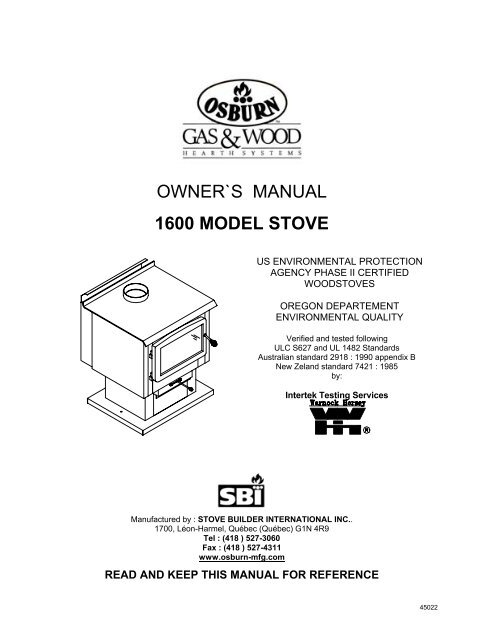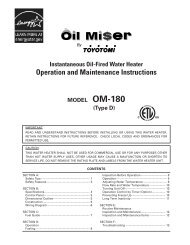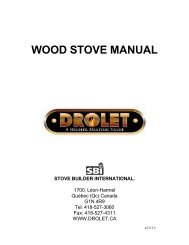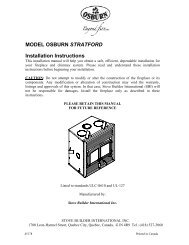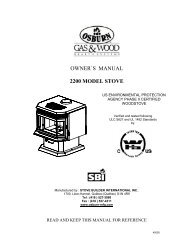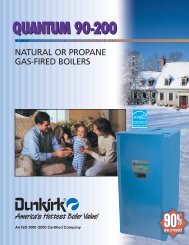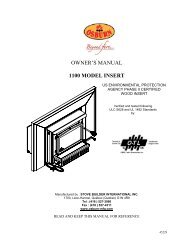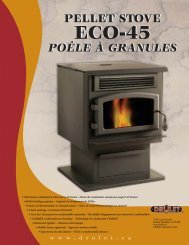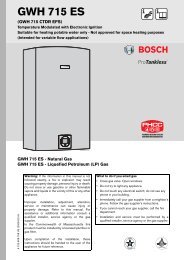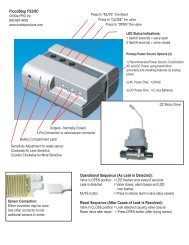Owner's Manual Osburn 1600 Wood Stove - Rural Energy ...
Owner's Manual Osburn 1600 Wood Stove - Rural Energy ...
Owner's Manual Osburn 1600 Wood Stove - Rural Energy ...
Create successful ePaper yourself
Turn your PDF publications into a flip-book with our unique Google optimized e-Paper software.
OWNER`S MANUAL<strong>1600</strong> MODEL STOVEUS ENVIRONMENTAL PROTECTIONAGENCY PHASE II CERTIFIEDWOODSTOVESOREGON DEPARTEMENTENVIRONMENTAL QUALITYVerified and tested followingULC S627 and UL 1482 StandardsAustralian standard 2918 : 1990 appendix BNew Zeland standard 7421 : 1985by:Intertek Testing ServicesManufactured by : STOVE BUILDER INTERNATIONAL INC..1700, Léon-Harmel, Québec (Québec) G1N 4R9Tel : (418 ) 527-3060Fax : (418 ) 527-4311www.osburn-mfg.comREAD AND KEEP THIS MANUAL FOR REFERENCE45022
TABLE OF CONTENTSINTRODUCTION................................................................................................................. 2TECHNICAL SPECIFICATIONS ......................................................................................... 3ASSEMBLY ......................................................................................................................... 4DOOR ADJUSTMENT..................................................................................................... 6THE BENEFITS OF INSTALLING A BLOWER ................................................................... 7INSTALLATION................................................................................................................... 8POSITIONING THE STOVE ............................................................................................ 8FLOOR PROTECTOR..................................................................................................... 9CLEARANCES FROM COMBUSTIBLES ...................................................................... 10REDUCED CLEARANCES (CANADA ONLY)............................................................... 12CHIMNEY ...................................................................................................................... 13CHIMNEY CONNECTOR (STOVE PIPE)...................................................................... 14TYPICAL INSTALLATIONS ........................................................................................... 15OUTSIDE COMBUSTION AIR....................................................................................... 19WOODSTOVE UTILISATION............................................................................................ 20AVERAGE ENERGY YIELD OF ONE AIR DRIED CORD OF CUT WOOD .................. 20TESTING YOUR WOOD ............................................................................................... 21THE FIRST FIRES......................................................................................................... 21IGNITION....................................................................................................................... 21HEATING....................................................................................................................... 22RELOADING.................................................................................................................. 23CREOSOTE FORMATION AND NEED FOR REMOVAL.............................................. 23ASH DISPOSAL ............................................................................................................ 24MAINTENANCE ................................................................................................................ 25GLASS...........................................................................................................................25GASKETING.................................................................................................................. 25PAINT ............................................................................................................................ 25LIMITED LIFETIME WARRANTY...................................................................................... 261
INTRODUCTIONSBI INC., one of the most important wood stove and fireplace manufacturers in Canada,congratulates you on your purchase and wishes to help you get maximum satisfactionfrom your wood stove. In the pages that follow, we will give you advice on wood heatingand controlled combustion as well as technical specifications regarding installation,operation and maintenance of the model you have chosen.The instructions pertaining to the installation of your wood stove comply with ULC-S627and UL-1482 standards.Read this entire manual before you install and use your new stove. If this stove isnot properly installed, a house fire may result. To reduce the risk of fire, follow theinstallation instructions. Failure to follow instructions may result in propertydamage, bodily injury, or even death.Consult your municipal building department or fire officials about restrictions andinstallations requirements in your area and the need to obtain a permit.Keep this instructions manual for future references.CAUTIONS:• HOT WHILE IN OPERATION. KEEP CHILDREN, CLOTHING AND FURNITURE AWAY. CONTACT MAYCAUSE SKIN BURNS.• DO NOT USE CHEMICALS OR FLUIDS TO IGNITE THE FIRE.• DO NOT LEAVE THE STOVE UNATTENDED WHEN THE DOOR IS SLIGHTLY OPENED.• DO NOT BURN WASTES, FLAMMABLE FLUID SUCH AS GASOLINE, NAPHTHA OR MOTOR OIL.• DO NOT CONNECT TO ANY AIR DISTRIBUTION DUCT OR SYSTEM.• ALWAYS CLOSE THE DOOR AFTER THE IGNITION.2
ASSEMBLYCAUTION: Operation of your <strong>Osburn</strong> stove without the baffle may cause unsafe andhazardous temperature conditions and will void the warranty.NOTE: Before installing the firebrick, check to ensure that none are broken or damaged inany way. If so, have the damaged ones replaced. Check the firebrick for damage at leastannually and replace any broken or damaged ones with new ones. Inspection andcleaning of the chimney is facilitated by the removable baffle.Install the two thin bricks into either side at the front. The 2.5" x 9" (64x229mm) pieceshould be placed at the bottom, placed so that the angled piece of the brick aligns with thebottom duct. Place the 4.5" x 2.5" (114x64mm) above it and under the brick retainer.FIGURE 2To install the baffle, follow these instructions (To remove, follow the reverse of theseinstructions):1- The ceramic insulation should be installed in place before the baffle bricks. Placethe first piece of ceramic insulation up inside the top of the firebox and place oneside over the baffle brick retainer so that the 13.5" (343mm) length goes from frontto back and the 10.5" ( 267mm) length goes from side to side as shown in Figure 2.The ceramic blanket should lie over the stainless steel tube, over one side of thebrick retainer and rest on the firebrick sides. The second piece of insulation shouldbe laid on the opposite side of the baffle brick retainer, over the stainless steel tubeand over the firebrick, directly beside the first piece of ceramic insulation withoutoverlapping as shown in Figure 2.Caution: As with all fibrous materials, avoid inhaling any airborne fibers.2- Place the two bricks with the corners cut out of them under the right and left sidebrick retainers and over the side bricks. They should fit so that the angled partslopes down toward the back.4
3- Place the two small 2" x 4 3/8" (51 x 111mm) bricks up into the top front sidespaces below the stainless steel tube.4- Place the baffle brick retainer up over the back duct and over the stainless steeltube so that the angled rib is on the top. Move it to the middle under the ceramicinsulation.5- Angle each of the two rear baffle bricks up to the top right or left and place them sothat they sit crosswise under the ceramic insulation, over the back duct, over theside bricks, and over the baffle brick retainer. Push them toward the back andmake sure that the insulation over them is flat.6- In the same way angle each of the two front baffle bricks up to the top front right orleft so that they sit crosswise under the ceramic insulation, over the stainless steeltube, over the baffle brick retainer, and over the side bricks. Push them toward thefront.7- Similarly, place the two middle baffle bricks crosswise between the front and rearbaffle bricks. Make sure that the insulation is flat over them. Push them toward theback so there are no gaps between the bricks.8- Reach up inside and lift the insulation up slightly while pushing the right, and thenthe left, front baffle bricks toward the back.9- Once all the bricks are in, make sure that the ceramic insulation is flat over andflush with the front edge of the bricks, and sealed against the firebox wall along theback and sides. Push all the baffle bricks toward the back and centre - do not allowthe bricks to sit on the angled rib of the baffle brick retainer.10- Place the included steel insulation weight at the top back centre of the ceramicinsulation. This weight will prevent the insulation from being drawn toward the fluehole, causing a possible blockage under extreme draft conditions. The metal platewill be located inside the firebox when the appliance is packaged.5
DOOR ADJUSTMENTIn order for your stove to operate properly, the door should be adjusted periodically toprovide an air tight fit. To adjust:• Remove the lock pin (spring pin) by pulling and turning it using pliers ("wise grip")• Turn the handle counter clock wise one turn to increase pressure• Re-install the lock pin (spring pin) with a small hammerFigure 1: Door Adjustment6
THE BENEFITS OF INSTALLING A BLOWERA blower can be installed at the back of your OSBURN stove. This option is necessary ifyou wish to redistribute into a room the heat trapped at the back of your stove. By forcinghot air toward the front, the blower enables you to extend the radiation power of yourstove.You can purchase this option through your OSBURN dealer. Make sure to specify thispart number: # OA10505 or #OA10360 for Australia.7
INSTALLATIONSAFETY NOTICE• IF THIS STOVE IS NOT PROPERLY INSTALLED, A HOUSE FIRE MAY RESULT. TO REDUCE THE RISKOF FIRE, FOLLOW THE INSTALLATION INSTRUCTIONS. FAILURE TO FOLLOW INSTRUCTIONS MAYRESULT IN PROPERTY DAMAGE, BODILY INJURY, OR EVEN DEATH.• CONSULT YOUR MUNICIPAL BUILDING DEPARTMENT OR FIRE OFFICIALS ABOUT RESTRICTIONSAND INSTALLATIONS REQUIREMENTS IN YOUR AREA.• USE SMOKE DETECTORS IN THE ROOM WHERE YOUR STOVE IS INSTALLED.• KEEP FURNITURE AND DRAPES WELL AWAY FROM THE STOVE.• NEVER USE GASOLINE, GASOLINE-TYPE LANTERN FUEL, KEROSENE, CHARCOAL LIGHTER FLUID,OR SIMILAR LIQUIDS TO START OR "FRESHEN UP" A FIRE. KEEP ALL SUCH LIQUIDS WELL AWAYFROM THE STOVE.• IN THE EVENT OF A CHIMNEY FIRE, PUSH THE AIR CONTROL FULL CLOSED TO DEPRIVE THE FIREOF OXYGEN. CALL THE FIRE DEPARTMENT.• DO NOT CONNECT TO ANY AIR DISTRIBUTION DUCT OR SYSTEM.• A SOURCE OF FRESH AIR INTO THE ROOM OR SPACE HEATED SHALL BE PROVIDED WHENREQUIRED.POSITIONING THE STOVEIt is very important to position the wood stove as close as possible to the chimney, and inan area that will favour the most efficient heat distribution possible throughout the house.The stove must therefore be installed in the room where the most time is spent, and in themost spacious room possible. Recall that wood stoves produce radiating heat, the heatwe feel when we are close to a wood stove. A wood stove also functions by convection,that is through the displacement of hot air accelerated upwards and its replacement withcooler air. If necessary, the hot air distribution from the stove may be facilitated by theinstallation of a blower.The wood stove must not be hooked up to a hot air distribution system since anexcessive accumulation of heat may occur.A wood stove must never be installed in a hallway or near a staircase, since it mayblock the way in case of fire or fall to respect required clearances.8
FLOOR PROTECTORYour wood stove should be placed on a non-combustible surface. The floor protectorshould be under the stove, eighteen inches beyond the front and eight inches beyond eachside of the fuel loading and ash removal opening. If there is a horizontal section ofchimney connector, the floor protector should go under it and two inches beyond eachside.The floor protector should exceed the stove as follows:FRONTSIDESBACK18’’(460 mm)8’’(200 mm)8’’(200 mm)9
CLEARANCES FROM COMBUSTIBLESIt is of outmost importance that the clearances to combustible materials be scrupulouslyrespected upon installation of the stove you have selected. Refer to the tables below :VERTICAL& HORIZONTALSINGLEWALLCONNECTORSECURITYDOUBLEWALLINDUSTRIALCHIMNEYCOMPANYDOUBLEWALLTo Unit:Sidewall ABackwall BCorner CTo Connector:Sidewall DBackwallE16.5" (419 mm)15" (318 mm)11.5" (292 mm)26" (660 mm)21" (533 mm)20.5" (521 mm)6" (152 mm)5.5" (140 mm) CAN.29" (737 mm)25" (635 mm) CAN.10" (254 mm)16.5" (420 mm)6" (15 mm)6" (150 mm)25" (635 mm)10" (254 mm)CornerF23.5" (597 mm)16" (406 mm)12" (305 mm)From Hearth:Ceiling Height84" (2135 mm)84" (2135 mm)84" (2135 mm)• Floor to ceiling height must be at least 7' (84") in all cases.• The clearance between the flue pipe and a wall are valid only for vertical walls and forvertical flue pipe.• The flue pipe must not go through roof trussing, an attic, a wardrobe, a floor, acombustible partition, or similar spaces.• A flue pipe crossing a combustible wall must have a minimum clearance of 18".• To reduce flue pipe clearances from combustible materials, contact your local safetydepartment.10
CHIMNEYYour wood stove may be hooked up with a factory built or masonry chimney. If you areusing a factory built chimney, it must comply with UL 103 or ULC S629 standards;therefore it must be a Type HT (2100°F). It is extremely important that it be installedaccording to the manufacturer's specifications.If you are using a masonry chimney, it is important that it be built in compliance with thespecifications of the National Building Code. It must be lined with fire clay bricks, metal orclay tiles sealed together with fire cement. (Round flues are the most efficient).The interior diameter of the chimney flue must be identical to the stove smoke exhaust. Aflue which is too small may cause draught problems, while a large flue favours rapidcooling of the gas, and hence the build-up of creosote and the risk of chimney fires. Notethat it is the chimney and not the stove which creates the draught effect; your stove'sperformance is directly dependent on an adequate draught from your chimney.The following recommendations may be useful for the installation of your chimney:1. Do not connect this unit to a chimney flue serving another appliance.2. It must rise above the roof at least 3' (0.9 mm) from the uppermost point ofcontact.3. The chimney must exceed any part of the building or other obstruction within a10' (3.04 m) distance by a height of 2' (0.6 m).4. Installation of an interior chimney is always preferable to an exterior chimney.Indeed, the interior chimney will, by definition, be hotter than an exteriorchimney, being heated up by the ambient air in the house. Therefore the gaswhich circulates will cool more slowly, thus reducing the build-up of creosoteand the risk of chimney fires.5. The draught caused by the tendency for hot air to rise will be increased with aninterior chimney.6. Using a fire screen at the extremity of the chimney requires regular inspection inorder to insure that it is not obstructed thus blocking the draught, and it shouldbe cleaned when necessary.13
CHIMNEY CONNECTOR (STOVE PIPE)Your chimney connector and chimney must have the same diameter as the stove outlet. Ifthis is not the case, we recommend you contact your dealer in order to insure there will beno problem with the draught.The stove pipe must be made of aluminized or cold roll steel with a minimum thickness of0.021" or 0.53 mm. It is strictly forbidden to use galvanized steel.Your smoke pipe should be assembled in such a way that the male section of the pipefaces down. Attach each of the sections to one another with three equidistant metalscrews.The pipe must be short and straight. All sections installed horizontally must slope at least1/4 inch per foot, with the upper end of the section toward the chimney.To insure a good draught, the total length of the coupling pipe should never exceed 8' to10' (24 to 3.04 m). (Except for cases of vertical installation, cathedral-roof style where thesmoke exhaust system can be much longer and connected without problem to thechimney at the ceiling of the room).There should never be more than two 90 degrees elbows in the smoke exhaust system.Installation of a "barometric draught stabiliser" (fireplace register) on a smoke exhaustsystem is prohibited.Furthermore, installation of a draught damper is not recommended. Indeed, with acontrolled combustion wood stove, the draught is regulated upon intake of the combustionair in the stove and not at the exhaust.<strong>Stove</strong> Pipe14
TYPICAL INSTALLATIONSFACTORY BUILT CHIMNEY:RAIN CAPROOF FLASHING18" CLEARANCEWALL RADIATION SHIELDRADIATION SHIELDWALL SUPPORTCEILING SUPPORTWall installationVertical installation15
MASONRY CHIMNEY:Clay linerThimbleClean outdoor16
FACTORY BUILT THIMBLE:17
BRICK THIMBLE:18
Smaller pieces of wood will dry faster. All logs exceeding 6" in diameter should be split.The wood should not be stored directly on the ground. Air should circulate through thecord. A 24" to 48" air space should be left between each row of logs, which should beplaced in the sunniest location possible. The upper layer of wood should be protectedfrom the element but not the sides.TESTING YOUR WOODWhen the stove is thoroughly warmed, place one piece of split wood (about five inches indiameter) parallel to the door on the bed of red embers.Keep the air control full open by pulling on it and close the door. If ignition of the piece isaccomplished within 90 seconds from the time if was placed in the stove, your wood iscorrectly dried. If ignition takes longer, your wood is damp.If your wood hisses and water or vapour escapes at the ends of the piece, your wood issoaked or freshly cut. Do not use this wood in your stove. Large amounts of creosotecould be deposited in your chimney, creating potential conditions for a chimney fire.THE FIRST FIRESThe fresh paint on your stove needs to be cured to preserve its quality. Once the fuelcharge is properly ignited, only burn small fires in your stove for the first four hours ofoperation. Never open the air control more than necessary to achieve a medium burn rate.Make sure that there’s enough air circulation while curing the stove. The odours could besmelled during the 3 or 4 first fires. Never start your stove outside. You will not be able tosee if you are over heating.IGNITIONAfter making sure that the stove air intake controls are fully open (completely pull-outtowards you), place several rumpled sheets of paper in the centre of the combustionchamber. Place 8 to 10 pieces of small dry kindling wood over the paper in the form of atent. You may also place a few pieces of heating wood, but choose the smaller ones. Nochemical product should be used to light the fire.Before igniting the paper and kindling wood, it is recommended that you warm up thechimney. This is done in order to avoid back draft problems often due to negativepressure in the house. If such is the case, open a window slightly near the stove and twisttogether a few sheets of newspaper into a torch. Light up this paper torch and hold it asclose as possible to the mouth of the pipe inside the combustion chamber to warm up thechimney. Once the updraft movement is initiated, you are ready to ignite the stove bylighting the paper and kindling wood inside the combustion chamber.We therefore advise you to leave the door slightly opened (1/4") for a 10 to 30 minutesperiod, under supervision, in order to allow for good combustion. After this time, youmust close the door and progressively adjust the air control to obtain the desiredtemperature.21
HEATINGControlled combustion is the most efficient technique for wood heating because it enablesyou to select the type of combustion you want for each given situation. The wood will burnslowly if the wood stove air intake control is adjusted to reduce the oxygen supply in thecombustion chamber to a minimum. On the other hand, wood will burn quickly if the aircontrol is adjusted to admit a larger quantity of oxygen in the combustion chamber. Theair intake control on your stove is very simple. If you move it completely to the right, it isfully open. If you move it completely to the left, it is fully close.Your OSBURN stove burnt between .979 kg\h and 3.517 kg\h. of wood during EPA testing.Real operating conditions may give very different results than those obtained in the labaccording to the species of wood used, its moisture content, the size and density of thepieces, the length of the chimney, altitude and outside temperature.WARNINGS• NEVER OVERFIRE YOUR STOVE.IF ANY PART OF THE STOVE STARTS TO GLOW RED, OVERFIRING IS HAPPENING. READJUST THE AIR INTAKE CONTROL AT A LOWER SETTING.• THE INSTALLATION OF A LOG CRADLE IS NOT RECOMMENDED IN YOUR OSBURN WOOD STOVE.• NEVER PUT WOOD ABOVE THE FIREBRICK LINING OF THE FIREBOX.22
RELOADINGOnce you have obtained a good bed of embers, you should reload the unit. In order to doso, open the air controls to maximum a few seconds prior to opening the stove's door.Then proceed by opening the door very slowly; open it one or two inches for 5 to 10seconds, before opening it completely to increase the draught and thus eliminate thesmoke which is stagnant in a state of slow combustion in the stove. Then bring the redembers to the front of the stove and reload the unit.For optimal operation of your wood stove, we recommend you to operate it with a woodload approximately equivalent to the height of fire bricks.It is important to note that wood combustion consumes ambient oxygen in the room .In thecase of negative pressure, it is a good idea to allow fresh air in the room, either by openinga window slightly or by installing a fresh air intake system on an outside wall. Refer topage 16 of the present manual.CREOSOTE FORMATION AND NEED FOR REMOVALWhen wood is burned slowly, it produces tar and other organic vapours, which combinewith expelled moisture to form creosote. The creosote vapours condense in the relativelycool chimney flue of a slow-burning fire. As a result, creosote residue accumulates on theflue lining. When ignited this creosote makes an extremely hot fire. When burning wood,the chimney connector and chimney should be inspected at least once every two monthsduring the heating season to determine if a creosote build-up has occurred.We strongly recommend that you install a magnetic thermometer or probe on your smokeexhaust pipe, approximately 18" above the stove. This thermometer will indicate thetemperature of your gas exhaust fumes within the smoke exhaust system. The idealtemperature for these gases is somewhere between 275 o F and 500 o F. Below thesetemperatures, the build-up of creosote is promoted. Above 500 degrees, heat is wastedsince a too large quantity is lost into the atmosphere.TO PREVENT CREOSOTE BUILD UP• Always burn dry wood. This allows clean burns and higher chimney temperatures,therefore less creosote deposit.• Leave the air control full open for about 10 min. every time you reload the stove tobring it back to proper operating temperatures. The secondary combustion can onlytake place if the firebox is hot enough.• Always check for creosote deposit once every two months and have your chimneycleaned at least once a year.23
ASH DISPOSALAshes should be removed from the stove every few days or when ashes get to 2 to 3inches deep. Always empty the stove when it is cold, such as in the morning.Always dispose of ashes in a metal container with a tight fitting lid. Place this container ona non combustible floor or on the ground, well away from all combustible materials,pending final disposal. If the ashes are disposed of by burial in soil or otherwise locallydispersed, they should be retained in the close container until all cinders have thoroughlycooled.CAUTIONS:• ASHES COULD CONTAIN HOT EMBERS EVEN AFTER TWO DAYS WITHOUT OPERATING THE STOVE.• THE ASH PAN CAN BECOME VERY HOT. WEAR GLOVES TO PREVENT INJURY.• NEVER BURN THE STOVE WITH THE ASH TRAP OPEN. THIS WOULD RESULT IN OVER FIRING THESTOVE. DAMAGE TO THE STOVE AND EVEN HOUSE FIRE MAY RESULT.24
MAINTENANCEYour OSBURN stove is a high efficiency stove and therefore require little maintenance. Itis important to perform a visual inspection of the stove every time it is emptied, in order toinsure that no parts have been damaged, in which case repairs must be performedimmediately.GLASS• Inspect the glass regularly in order to detect any cracks. If you spot one, turn the stoveoff immediately. Do not abuse the glass door by striking or slamming shut. Do not usethe stove if the glass is broken.• If the glass on your stove breaks, replace only with glazing supplied from the OSBURNdealer.• To replace the glass, remove the screws retaining the gasket frame inside the door andlift. Replace the damaged piece with a new one. Perform the procedure backwardsafter replacing. When replacing the glass, you should change the glass gasket tomake sure you keep it sealed.• Never wash the glass with a product that may scratch. Use a specialized product,available in the stores where wood stoves are sold.• The glass should be washed only when cold.GASKETINGIt is recommended that you change the door gasket (which makes your stove door airtight) once a year, in order to insure good control over the combustion, maximumefficiency and security. To change the door gasket, simply remove the damaged one.Carefully clean the available gasket groove, apply a high temperature silicone sold for thispurpose, and install the new gasket. You may light up your stove again approximately 24hours after having completed this operation.WARNING:• NEVER OPERATE THE STOVE WITHOUT A GASKET OR WITH A BROKEN ONE. DAMAGE TO THESTOVE OR EVEN HOUSE FIRE MAY RESULTPAINTOnly clean your stove with a dry soft cloth that will not harm the paint finish.If the paint becomes scratched or damaged, it is possible to give your wood stove a brandnew look, by repainting it with a 1200 o F heat resistant paint. For this purpose, simplyscrub the surface to be repainted with fine sand paper, clean it properly, and apply thincoats (2) of paint successively. Refer to page 18 of the present manual for the paint curingprocess.25
1700, rue Léon-Harmel, Québec (Québec) G1N 4R9tel. : (418) 527-3060 fax : (418) 527-4311e-mail : tech@osburn-mfg.com web site : http://www.osburn-mfg.comLIMITED LIFETIME WARRANTYThe warranty of the manufacturer extends only to the original consumer purchaser and is not transferable. Thiswarranty covers brand new products only, which have not been altered, modified nor repaired since shipment fromfactory. Proof of purchase (dated bill of sale), model name and serial number must be supplied when making anywarranty claim to your OSBURN dealerThis warranty applies to normal residential use only. Damages caused by misuse, abuse, improperinstallation, lack of maintenance, over firing, negligence or accident during transportation are not coveredby this warranty.This warranty does not cover any scratch, corrosion or discoloration caused by over firing, abrasives or chemicalcleaners. Any defect or damage caused by the use of unauthorized parts or others than original parts void thiswarranty.An authorized qualified technician must perform the installation in accordance with the Instructions supplied with thisproduct and all local and national building codes. Any service call related to an improper installation is not coveredby this warranty.Returned products are to be shipped prepaid to the manufacturer for investigation. If a product is found to bedefective, the manufacturer will repair or replace such defect and reasonable transportation fees will be refund.Repair work covered by the warranty, executed at the purchaser domicile by an authorized qualified technicianrequires the prior approval of the manufacturer. Labour cost and repair work to the account of the manufacturer arebased on predetermined rate schedule and must not exceed the wholesale price of the replacement part.The manufacturer at its discretion may decide to repair or replace any part or unit after inspection and investigationof the defect. The manufacturer may, at its discretion, fully discharge all obligations with respect to this warranty byrefunding the wholesale price of any warranted but defective partsThe manufacturer shall in no event be responsible for any special, indirect, consequential damages of any nature,which are in excess of the original purchase price of the product.DESCRIPTIONWARRANTY APPLICATIONPARTSLABOURCombustion chamber (weldings only) Lifetime 5 yearsStainless baffle 5 years 1 yearCarbon steel baffle and secondary air tubes 2 years 1 yearHandle assembly 5 years n/aAsh drawer Lifetime 1 yearCast iron parts 5 years 1 yearCeramic glass (thermal breakage only) 1 year n/aPaint, refractory bricks, gasket, blower, thermal switch (thermodisc)and rheostat1 year n/aGold plating (tarnishing) / Brass plating not covered 1 year n/aShall your unit or a components be defective, contact immediately your OSBURN dealer. Prior to your call make sure you havethe following information necessary to your warranty claim treatment:• You name, address and telephone number;• Bill of sale, dealer’s name;• Serial number and model name as indicated on thenameplate fixed to the back of your unit;• Nature of the defect and any relevant information.Before shipping your unit or defective component to our plant, you must obtain from your OSBURN dealer anAuthorization Number. Any merchandise shipped to our plant without authorization will be refused automatically andreturned to sender.26


